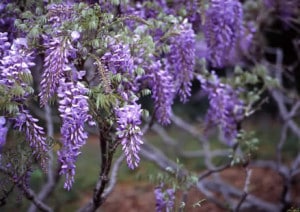 Learn to grow Wisteria — a beautiful, lovely, etherial vine.
Learn to grow Wisteria — a beautiful, lovely, etherial vine.
About Wisteria:
This long-lived twining, woody deciduous vine needs full sun, good drainage, a very strong support system, regular water the first season, and very-well amended soil (don’t forget the SureStart). Failure to get nutrients into the root zone at planting time can result in the common ‘my wisteria doesn’t bloom’ complaint, more on that below. Seed pods are poisonous.
Wisterias need a very strong, sturdy arbor, pergola or trellis since they can become very heavy with age. If the trellis is attached to the house, it should be planted on the farthest post, and let it fill in by gradually growing toward your house. They can clog the rain gutters, lift roof shingles, rip up flimsy trellises, and strangle small trees.
Basic Training: Train the main leader to the upper part of the support system and cut it off when it reaches the desired height. Train the main side branches horizontally at least 18’ apart from each other. The first season do not expect prolific blooms since vegetative growth is being encouraged to establish the scaffold/framework. Remove stems that interfere with the desired framework; pinch back side stems and long whips.
The young wisteria will send out a lot of skinny, rapidly-growing, soft vegetative shoots (which make leaves, not flowers) in the spring and summer. These shoots are called runners, or whips, and are roughly the thickness of a phone cord. Some of these can be forced into becoming a spur system by heading back to 3 to 6 inches from where they join their parent scaffold branch. Check out the Cass Turnbull “Guide To Pruning”, pp.196-201, for some great pictures and pruning advice. Page 199 has an excellent explanation of the spur system. Correctly pruning wisterias is another solution to “why doesn’t my wisteria bloom?” This plant will need dedicated pruning every winter and cleanup pruning every summer. NOTE: Wisteria flowers develop in buds near the base of the previous year’s growth.
Fertilizing: Wisteria need very little feeding once established, Nitrogen fertilizer will encourage vegetative growth, not blossoms. Sloat Garden Center’s Katy Thompson, Advanced CCN Pro, recommends an annual application of Agricultural Lime in the spring since wisteria like a neutral to slightly acid soil pH of 6.0-7.0
The difference between Chinese and Japanese Wisteria:
- Japanese: The pendulous flowers clusters (racemes) are 12”-18” long, and open gradually from the base of the cluster as the leaves are developing during May and June. They are very fragrant. The compound leaves usually have 13-29 leaflets. The vines twine clockwise.
- Chinese: The racemes open all at once (ooh, ah) in May, are 9”-12” long and have a mild sweet fragrance. The compound leaves have 7-13 leaflets, the vine twines counter-clockwise.
Trivia Note: A Chinese wisteria planted in 1894 by William and Alice Brugman in Sierra Madre, California now weighs more than 250 tons, is more than one acre in size and has become one of the seven horticultural wonders of the world. It is named by the Guinness Book of World Records as the largest blossoming plant in the world, and is the star of Sierra Madre’s annual Wisteria Festival.


